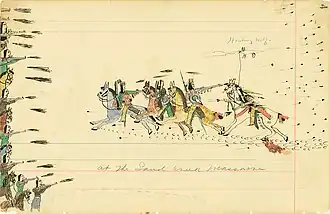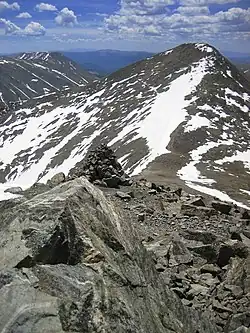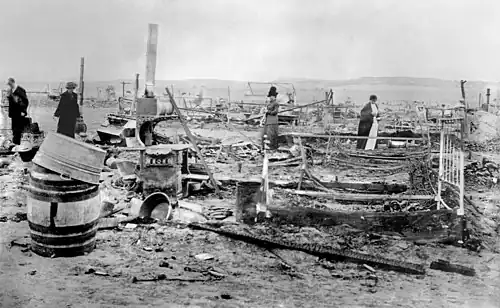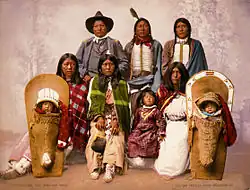Portal:Colorado/Selected article
WikiProject Colorado has selected the following articles for the Colorado portal.
Use
The layout design for these subpages is at Portal:Colorado/Selected article/Layout.
- Add a new selected article to the next available subpage.
- Biography articles should go on Portal:Colorado/Selected biography.
- The text should be approximately 60 words from the article.
- Update
{{Random portal component|max=total|seed=1|header=Selected article|subpage=Selected article}}on Portal:Colorado with the new selected article total.
Colorado selected articles list
Selected article 1
Portal:Colorado/Selected article/1

Selected article 2
Portal:Colorado/Selected article/2

Although there are many other hydrological divides in the Americas, the Continental Divide is by far the most prominent of these because it tends to follow a line of high peaks along the main ranges of the Rocky Mountains and Andes, at a generally much higher elevation than the other hydrological divisions. (Full article...) (Full article...)
Selected article 3
Portal:Colorado/Selected article/3

The camp, located 1.3 miles (2.1 km) southwest of the small farming community of Granada, south of U.S. Highway 50, was listed on the National Register of Historic Places on May 18, 1994, and designated a National Historic Landmark on February 10, 2006. On March 18, 2022, U.S. President Joe Biden signed the Amache National Historic Site Act authorizing the Granada War Relocation Center to become part of the National Park System. It was formally established as part of the National Park Service on February 15, 2024, the third National Historic Site in Colorado after Bent's Old Fort and the site of the Sand Creek Massacre. (Full article...) (Full article...)
Selected article 4
Portal:Colorado/Selected article/4
The site was declared a National Historic Landmark on January 20, 1961. The United States National Park Service has studied the possibility of making the Lindenmeier site a United States National Monument. (Full article...) (Full article...)
Selected article 5
Portal:Colorado/Selected article/5

The massacre was the seminal event of the 1913–1914 Colorado Coalfield War, which began with a general United Mine Workers of America strike against poor labor conditions in CF&I's southern Colorado coal mines. The strike was organized by miners working for the Rocky Mountain Fuel Company and Victor-American Fuel Company. Ludlow was the deadliest single incident during the Colorado Coalfield War and spurred a ten-day period of heightened violence throughout Colorado. In retaliation for the massacre at Ludlow, bands of armed miners attacked dozens of anti-union establishments, destroying property and engaging in several skirmishes with the Colorado National Guard along a 225-mile (362 km) front from Trinidad to Louisville. From the strike's beginning in September 1913 to intervention by federal soldiers under President Woodrow Wilson's orders on April 29, 1914, an estimated 69 to 199 people were killed during the strike. Historian Thomas G. Andrews declared it the "deadliest strike in the history of the United States."
The Ludlow Massacre was a watershed moment in American labor relations. Historian and author Howard Zinn described it as "the culminating act of perhaps the most violent struggle between corporate power and laboring men in American history". Congress responded to public outrage by directing the House Committee on Mines and Mining to investigate the events. Its report, published in 1915, was influential in promoting child labor laws and an eight-hour work day. The Ludlow townsite and the adjacent location of the tent colony, 18 miles (29 km) northwest of Trinidad, Colorado, is now a ghost town. The massacre site is owned by the United Mine Workers of America, which erected a granite monument in memory of those who died that day. The Ludlow tent colony site was designated a National Historic Landmark on January 16, 2009, and dedicated on June 28, 2009. Subsequent investigations immediately following the massacre and modern archeological efforts largely support some of the strikers' accounts of the event. (Full article...) (Full article...)
Selected article 6
Portal:Colorado/Selected article/6
The battle took place at the eponymous mountain pass in the Sangre de Cristo Mountains, in what is now Santa Fe County, New Mexico. Confederate forces sought to break the Union's possession of the West along the base of the Rocky Mountains, with the ultimate aim of controlling strategically valuable mines, railroads, and cities throughout the region. The invasion was the westernmost military operation of the war, and the South's only real attempt to conquer and occupy Union territory.
A skirmish occurred on March 26 between advance elements from each army, with the main battle occurring on March 28. Although the Confederates were able to push Union forces back through the pass, they had to retreat when their supply train was destroyed and most of their horses and mules were killed or driven off. Eventually, the invading force was forced to withdraw entirely from the territory, with the Union retaking full control by June. (Full article...) (Full article...)
Selected article 7
Portal:Colorado/Selected article/7

Their Ute dialect is a Colorado River Numic language, part of the Uto-Aztecan language family
Historically, the Utes belonged to almost a dozen nomadic bands, who came together for ceremonies and trade. They also traded with neighboring tribes, including Pueblo peoples. The Ute had settled in the Four Corners region by 1500 CE. (Full article...) (Full article...)
Selected article 8
Portal:Colorado/Selected article/8
The range is oriented along a northwest–southeast axis, extending roughly 80 miles (130 km) from in the north to in the south. The range contains fifteen peaks in excess of 14,000 feet (4,267 m), also known as fourteeners. The range forms a part of the Continental Divide, and its eastern side drains into the headwaters of the Arkansas River. The western side of the range feeds the headwaters of the Roaring Fork River, the Eagle River, and the Gunnison River, tributaries of the Colorado River.
The Sawatch mountains in general are high, massive, and relatively gentle in contour. While some peaks are rugged enough to require technical climbing, most can be climbed by a simple, yet arduous hike. Notable summits include Mount Elbert, Mount Massive, La Plata Peak, Mount of the Holy Cross, and the Collegiate Peaks (Mounts Columbia, Harvard, Princeton, Yale, Belford, and Oxford). (Full article...) (Full article...)
Selected article 9
Portal:Colorado/Selected article/9

Selected article 10
Portal:Colorado/Selected article/10
Selected article 11
Portal:Colorado/Selected article/11 Mike the Headless Chicken (April 20, 1945 – March 17, 1947) was a male Wyandotte chicken that lived for 18 months after he was beheaded, surviving because most of his brain stem remained intact, and a blood clot prevented him from bleeding to death. After the beheading, Mike achieved national fame; he died in March 1947. In his hometown, Fruita, Colorado, U.S., an annual "Mike the Headless Chicken Day" is held in May. Mike has the record for the longest surviving chicken without a head in Guinness World Records. (Full article...) (Full article...)
Nominations
- Feel free to add an article.
- Biographies should go on Portal:Colorado/Selected biography.
- If you are unsure or do not know how to add an entry, please ask for help at the Portal talk:Colorado talk page.